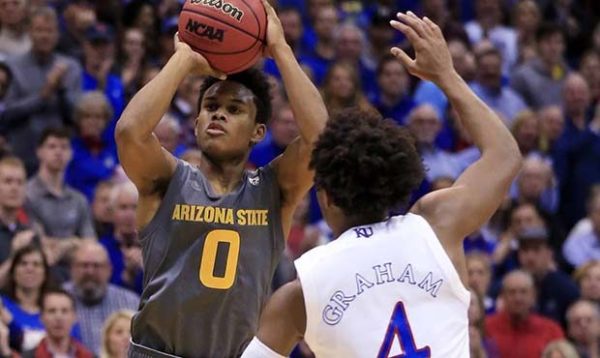Reinforcements Can Help Kansas, But Not Where the Jayhawks Need It Most
Posted by Brian Goodman on December 12th, 2017With the end of the semester approaching, 7-2 Kansas is due to receive some help with the addition of transfer wing Sam Cunliffe, and the possibility remains that some combination of big men Billy Preston and Silvio De Sousa could also come on board as both work toward gaining eligibility. Though the Jayhawks could certainly use some additional frontcourt depth, any reinforcements they receive should not be mistaken for a cure-all as they look to bounce back from consecutive regular season losses for the first time since 2013.

Kansas’ perimeter-oriented approach has worked well, but not without some glaring weaknesses. (AP Photo/Orlin Wagner)
As thin as Bill Self‘s team is down low, Kansas’ two-point defense remains among the very best in the country. Even after getting carved up by Arizona State on Sunday, the Jayhawks still rank among the top 30 nationally in two-point defense and 10 best in adjusted defensive efficiency. Although some help on the low blocks could keep Udoka Azubuike from worrying about foul trouble and prevent the head coach from turning to unusual measures like relying on a walk-on to play key minutes against power conference teams and dipping into the football roster for help, what would really make this defense whole is greater urgency from the backcourt in adequately defending the perimeter.
After ranking among the top half of college basketball in defensive three-point attempt rate in each of the last four seasons, Kansas ranks 295th in the same category nine games into this season. The defensive weaknesses of LaGerald Vick and Svi Mykhailiuk were on full display in the Jayhawks’ two losses last week, as Washington’s Matisse Thybulle and Arizona State’s Tra Holder and Shannon Evans roasted their defense for a combined 58.3 percent clip from beyond the arc. It’s important to note that there is some statistical noise at play here in that Kansas has played three teams (South Dakota State, Toledo and Arizona State) that live and die by the three just like they do, but there’s more to it than just those three teams.
There are some highly visible kinks to work out on the offensive end as well. Self’s vaunted backcourt continues to make three-pointers at a very high rate, but they’re running into historic struggles when it comes to drawing whistles and creating opportunities for easy points. It’s been 10 years since Kansas ranked outside of the top 150 nationally in offensive free throw rate, but it currently ranks 349th in that metric. The Jayhawks’ biggest issue offensively isn’t that they’re too reliant on the three-ball, but rather that they lack guards who can make high-percentage plays off the dribble and get opponents into foul trouble when shots aren’t falling. Malik Newman came to Lawrence with the reputation of someone who could fill that specific role, but his 11 attempts from the foul line this year are the lowest among regulars for a team that has struggled mightily to get to the stripe. Playing in one of the most home-friendly environments in all of college basketball, the Jayhawks attempted just nine free throws against Arizona State on Sunday. By comparison, Arizona State’s Holder attempted 12 by himself.
To be clear, these are still mostly first-world problems as the Jayhawks are still projected to win their 14th consecutive regular season Big 12 title and nab a high seed in the NCAA Tournament. The likelihood is that they’re going to be just fine and some additional depth would be a welcome addition. But if Kansas is going to make good on its Final Four potential, the backcourt has to do a considerably better job in locking down the perimeter and improving its playmaking ability.












































